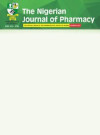Assessment of Knowledge of Anticoagulation Therapy (Warfarin) And INR Control Among Outpatients in A Tertiary Hospital in Lagos, Nigeria
Keywords:
Warfarin knowledge, anticoagulation, INR controlAbstract
Method: The study was a consecutive cross-sectional survey. Patients (n= 70) on warfarin and visiting outpatient clinic of the cardiology unit from July 2016- September 2016 were recruited upon their consent and asked to complete the AKA questionnaire. Demographic and clinical data were manually extracted from patients' record data. Passing score was defined as at least 12 correct responses out of 23- INR relevant AKA questions (52%). INR control was defined by 3 outcome measures: number of INRs within goal range, time in therapeutic range (TTR), and standard deviation (SD) of INR values.
Result: Seventy patients enrolled for this study and 85.7% (n= 60) of the recruited patients consented to participate (females 45%; mean age+ SD 60.07+7.75; % with post-secondary education 28.3%). Most patients (n=52) had goal INR ranges of 2.0 to 3.0 (86.6%). Forty-five percent (n= 27) of participants had adequate knowledge of warfarin. There was no significant relationship between number of correct INR-relevant responses and INR control as defined by any of the 3 measures (count of INR values within range rho= 0.070, P= 0.595;TTR rho= 0.092, P= 0.595; and SD rho= 0.118, P=0.371).
Conclusion: Less than half of the participants had adequate knowledge of warfarin use and there was no significant relationship between patient warfarin knowledge and INR control. However, a more robust multiple centred survey is recommended before generalizability of outcomes.
References
Khan, T.I., Kamali, F.,Kesteven, P., Avery, .P, & Wynne, H. (2004). The value of education and self-monitoring in the management of warfarin therapy in older patients with unstable control anticoagulation.British Journal of Haematology; 126:557-564.
Kagansky, N., Knobler, H., Rimon, E., Ozer, Z., & Levy, S.(2004). Safety of Anticoagulation Therapy in Well-informed Older Patients. Archives of Internal Medicine; 164:2044-2050.
Ansell, J Hirsh, J., Hylek, E.(2008) Pharmacology and management of the vitamin K antagonists. Chest: 133:1605-1
Taylor F. C., Ramsay, M.E., Tan G., Gabbay, J., Cohen, H.(1994). Evaluation of patients’ knowledge about anticoagulation treatment. Quality Health Care;3(2):7988.
Oramasionwu C. U., Bailey S. C.,Duffey K.E., Shilliday B.B.,Brown LC, Denslow SA &Michalets EL (2014). The association of health literacy with time in therapeutic range for patients on warfarin therapy. J Health Commun, 19(2):19-28
Baker JW, Pierce KL, Ryals CA(2011). INR goal attainment and oral anticoagulation knowledge of patients enrolled in an anticoagulation clinic in a Veterans Affairs medical center. J Manag Care Pharm.
:133-142
Tang E. O, Lai C.S, Lee K.K.,Wong R.S.,Cheng G.& Chan T.Y.(2003). Relationship between patients’ warfarin knowledge and anticoagulation control. Annals of Pharmacotherapy; 37:34-39
Zeolla MM, Brodeur MR, Dominelli A, Haines ST, and Allie ND (2006). Development and Validation
of an Instrument to Determine Patient knowledge: The Oral Anticoagulation Knowledge Test. Annals of
Pharmacotherapy 40(4)633-638
Briggs AL, Jackson TR, Bruce S., & Shapiro NL (2005). The development and performance validation of a tool to assess patient anticoagulation knowledge. Res Social Adm Pharm. 1(1)40-59.
Rosendaal FR, Cannegieter SC, van der Meer FJ, Briet E.(1993). A method to determine the optimal
intensity of oral anticoagulant therapy. Thromb Haemost;69:2369.
Ahmed Y Mayet (2015). Association between Oral Anticoagulation Knowledge, Anticoagulation Control, and Demographic Characteristics of Patients Attending an Anticoagulation Clinic in Saudi Arabia: A Cross-Sectional Prospective Evaluation. Trop | Pharm Res, 14(7): 1285 - 1291
Mariamma, K., & Cheryle, G.(2001). A review of warfarin dosing and monitoring. Baylor University Medical Center Proceedings; 14(3)305-306.
Fihn, S.D., McDonell, M., Martin, D. (1993). Risk factors for complications of chronic anticoagulation: a multicentre study. Annals of Internal Medicine; 118: 511 - 520
Connolly SJ, Pogue J, Eikelboom J, Flaker G. et al(2008). Benefit of oral coagulant over antiplatelet therapy in atrial fibrillation depends on the quality of international normalized ratio control achieved by center and countries as measured by time in therapeutic range. Circulation; 118: 2029-37
Jones M, McEwan P, Morgan CL, Peters JR, Goodfellow J, Currie CJ (2005). Evaluation of the pattern of treatment, level of anticoagulation fibrillation: A record linkage study in a large British population. Heart;91:472-7.
Veeger NJ, Piersma-Wichers M, Tijssen JGP, Hillege HL,Meer J (2005). Individual time within target range in patients treated with Vitamin K antogonist: Main determinant of anticoagulation and
predictor of clinical outcome. A retrospective study of 2300 consecutive patients with venous thromboembolism. Br J Haematol; 128:513-519
White HD, Gruber M, Feyzi J et al (2007). Comparison of outcomes among patients randomized to warfarin therapy according to control: Results from SPORTIF III and V. Arch Intern Med; 167:239-45.
Laila MM, Khaldoon MR, Syed SS, Mohamed AH & Muhamad AA (2013). Relationship between
warfarin knowledge and anticoagulation control: results



